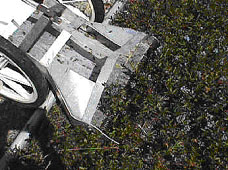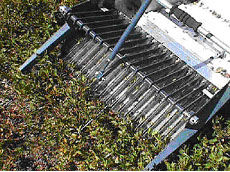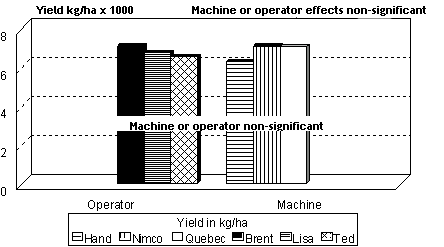226-Progress Towards the Development of a Mechanical Harvester for Wild Blueberries
Fact Sheet No. 226, UMaine Extension No. 2236
Prepared by David E. Yarborough, Extension Blueberry Specialist, The University of Maine, Orono, ME 04469. Published as Maine Agricultural and Forestry Experiment Station Publication No. 2454. February 2001.
Summary
Over the past 100 years, the wild blueberry (Vaccinium angustifolium with minor populations of V. myrtilloides) has been hand harvested with a metal rake similar to the cranberry scoop. Because harvest of the blueberry fruit constitutes the greatest expense in producing the crop, there is interest in reducing this cost by mechanical harvesting. Recent yield increases and a labor shortage has increased the need for an efficient mechanical harvester for wild blueberries. Past evaluations indicate that considerable cost savings may be realized by using mechanical harvesters but losses in yield, destruction of plants and reduced quality of the harvested berries may also result. New developments in blueberry mechanical harvester’s picking head efficiencies and the newest innovation with canoe-shaped teeth have resulted in improved harvest efficiency. These modifications have also resulted in yields equivalent to hand-harvesting while retaining high-quality fruit.
Introduction
The wild blueberry crop has been traditionally harvested with a hand-held metal rake, which was designed after the cranberry scoop. Because the harvest of the blueberry fruit is the largest expense in producing the crop (Yarborough, 1992b), there has always been interested in reducing this cost with a mechanical harvester. The low stature of the plant, uneven terrain of the fields, and competition from other weed species present formidable obstacles. Machines have been developed with picking heads ranging from the 0.6 m rake on wheels, which is commonly used in Quebec, to the 6 m wide ‘blueberry monster harvester’ which never made it more than 100 m into a field because of its massive weight. The most commonly used harvester is the Bragg harvester, which has an open reel picking head that was developed at the University of Maine (Dale et al., 1994). This harvester is made in Canada, where over 650 have been produced (Lloy, 2000).
A more than three-fold increase in yield of the wild blueberry crop over the past 20 years (Yarborough, 1997) and a shortage of labor due to the strong economy has increased the demand for a reliable mechanical harvester. Past evaluations of mechanical harvesters indicate that considerable cost savings may be realized by using mechanical harvesters but losses in yield, destruction of plants and reduced quality of the harvested berries may also result (Marra et al, 1989). Mechanical harvesters typically use steel teeth on a rotating head or a large scoop similar to a hand rake (Figure 1). The newest innovation uses canoe-shaped teeth (Figure 2), which has resulted in improved harvest efficiency with equivalent yields to hand-harvest while retaining high-quality fruit (Sibley, 1994).


A more detailed description of the development of mechanical harvesters for wild blueberries may be found in Dale et al (1994). This paper will evaluate new improvements in picking head efficiencies and the newest innovation in blueberry mechanical harvester’s picking head which has canoe-shaped teeth.
Study Methods
Mechanical Harvesters
On August 15-16, 1994, three machines were evaluated: the Bragg harvester, a Bragg Harvester modified with an electro-hydraulic head speed control system (Sibley, 1993), and a prototype Nimco harvester with the canoe-tooth configuration. All were compared to hand-harvesting on two commercial blueberry fields. One field was a land leveled field in T-19 M.D., Maine, with plant height of 20 to 30 cm and the other was without land leveling in Deblois, Maine, with plant height 15 to 20 cm. The experimental design was a randomized complete block with eight replications. A 46 m strip was harvested by each machine or hand harvested. The strips are located directly adjacent to each other to minimize field variability. Time to harvest and berry weights were obtained for each machine. The yield was converted to kg/ha and time to hr/ha for comparison and analyzed using the General Linear Model of the SAS program (Freund and Littell, 1981).
Machines were assessed as they were working in the field, no attempt was made to optimize performance since performance trials had been conducted with Bragg harvesters by Sibley (1993) and these data were available for comparison.
Non-Mechanized Harvesters
Hand raking was compared to the non-mechanized rake on wheels commonly used in Quebec (Figure 1) and to a non-mechanized Nimco harvester with the canoe-tooth configuration (Figure 2). The experimental design was a split plot with three operators using the three machines three times on a 13 m strip. The trial was conducted at the Blueberry Hill Farm Agricultural Experiment Station in Maine in August 1999. Time to harvest plot and berry weights were measured and converted to hr/ha and kg/ha respectively and analyzed using the General Linear Model of the SAS program (Freund and Littell, 1981).
Results

Mechanized Harvesters
Engineering assessment of this trial was provided by Sibley (1994). Observations on the Bragg harvester indicated it had worn rollers and its forward speed was too fast. Although the skill of the operator was judged to be excellent, the machine recovered only 69% of the berries relative to hand harvest in T-19 and 59% in Deblois (Figure 3). Each site had a different modified Bragg harvester. In T-19, the head speed to groundspeed ratio was too fast, reducing the machine efficiency.
On the Deblois site, the modified Bragg harvester had worn cams, the automatic mode of the electronic head-speed control system was malfunctioning, and the operator skill was poor, resulting in excessive time in which the picking head was off the ground. The modified Bragg harvester was able to obtain 61% of the hand-harvested yields at both locations (Figure 4).
The Nimco prototype harvester had a new picking action which appeared to be superior to anything tried in wild blueberries before. The canoe-shaped teeth provided excellent stripping action without pulling up plants, as happens with the reel-style harvesters and hand rakes. This action eliminated crushing and the picked berries appeared to have superior quality versus the Bragg or hand-harvested berries. The picking head used a system of sensors in front of the head which allowed the head to lift over hummocks and small obstructions which kept the picking head from digging into the ground. The Nimco out-performed the rakers by picking 107% of the hand harvest yield on the land leveled fields in T-19, but only picked 92% of the hand harvest in Deblois where the field was not land leveled (Figure 3). The Nimco prototype harvester was mounted on a walk-behind tractor and the speed and maneuverability were poor.

The effective field capacity of the Bragg harvesters was determined to be 0.116 ha/hr (1.16 ha/ 10 hr day) which is consistent with the 2.24 ha/10 hr day for the two headed Bragg machine measured by Marra et al. (1988). The hand rakers averaged 0.135 ha/ 6 hr day (44hr/ha) which means a Bragg harvester can do the work of more than 8 field rakers assuming they would work 6 hours. The Nimco prototype was not on a suitable harvesting platform to be evaluated for harvest efficiency. Evaluations of fruit quality taken in the trial indicated there was less crushed fruit with the hand and Nimco harvesters and less crushed fruit on the land-leveled fields.
Non-Mechanized Harvesters
There were no significant differences among the three operators or between the two machines and hand-harvest for the yields of blueberry fruit recovered (Figure 4), which was in excess of 7,000 kg/ha. There were highly significant differences among the operators for speed of harvest, ranging from 25 to 50 hr/ha and also between hand-harvest at 58 hr/ha, the Nimco harvester at 36 hr/ha, and the Quebec harvester at 29 hr/ha (Figure 5).
Discussion

Mechanized Harvesters
The land-leveled field allowed for greater blueberry recovery for the Bragg and Nimco harvesters, indicating that smoother fields will allow for more efficient harvesting. Poor maintenance, adjustment, and skill of the operator contributed to low fruit recovery observed for the Bragg and modified Bragg harvesters compared to hand harvest. This illustrates maintenance is essential in order to for the machines to perform properly. Sibley (1993) indicated that 92% recovery could be obtained by using a properly adjusted and operated Bragg harvester. All Bragg harvesters are now made with an electro-hydraulic head speed control which optimizes berry recovery. Bragg harvesters are the most commonly used with more than 650 picking heads already in use with an additional 70 machines produced each year (Lloy, 2000). At a cost of $30,000 CDN, ($19,500 US) it requires a tractor, which is an expensive item for a small grower. Sibley (1995) has developed a software program that will allow growers to evaluate the cost and efficiency of the Bragg harvester. A lease program in Canada now allows growers to have a tractor and harvester for $7,000 CDN ($4,500US) per year making this option more available to small growers with limited capital.
The Nimco prototype harvester has great potential, but only if it is properly mounted to allow it to cover the fields at a speed similar to the Bragg harvesters. There have been some significant improvements to the Nimco harvester since the last evaluation. Gidge (2000) indicates that he will have a self-propelled Nimco harvester with a picking head that has 15 of the Saberä channels that have canoe-shaped teeth with a conveyor to bring the fruit to boxes on the harvester. This system of getting the fruit from the rake to the box will enhance the efficiency of the machine. The harvester will be designed as a self-propelled unit that will follow the contour of the terrain. Additional evaluations are planned for this machine when it is available for field trials in 2001.
Non-Mechanized Harvesters
The use of the non-mechanized harvesters provides a mechanical advantage of 1.6x for the Nimco harvester and 2x for the Quebec harvester. This provides for greater efficiency than hand harvest, but a mechanized self- propelled machine would provide a greater advantage (Yarborough 1992a). There is still a need to develop this type of harvester for the grower with small field size.
References
Dale, A., E. J. Hanson, D.E. Yarborough, R.J. McNicol, E.J. Stang, R. Brenan, J. Morris and G.B. Hergert. 1994. Mechanical Harvesting of Berry Crops. Horticultural Reviews, ed. J. Janick. John Wiley & Sons. 16:255-382.
Lloy, R. 2000. Personal communication. Bragg Lumber Company, Collingwood, Nova Scotia, Canada.
Marra, M.C., T.A. Woods, R. Parker, N.N. San and M. Teisl. 1989. A comparison of lowbush blueberry harvesting technologies; Experimental and economic results from the 1988 field tests in Washington County, Maine. Bulleting No. 825. Maine Agricultural Experiment Station, University of Maine, Orono, ME, 46 pgs.
Freund, R.J. and R.C. Littell. 1981. SAS for linear models. SAS Institute Inc., Cary, North Carolina, USA. 231pgs.
Sibley, K.J. 1994. Wild Blueberry Harvesting Technologies: Engineering Assessment.
Sibley, K.J. 1995. H-OPCO$T V 1.0. Mechanical Wild Blueberry Harvester Cost Analysis Software. Sibley Engineering, Great Village, NS, Canada. 29 pgs.
Yarborough, D.E. 1992a. A comparison of three mechanical harvesters and hand raking for wild blueberries. HortScience. 27:60 (Abstract).
Yarborough, D.E. 1992b. Blueberry Enterprise Budget. Wild Blueberry Fact Sheet No. 260. University of Maine Cooperative Extension, Orono, Maine, USA. 3 pg
Yarborough, D.E. 1997. Production Trends in the Wild Blueberry Industry in North America. Acta Horticulturae. 446:33-35.
Information in this publication is provided purely for educational purposes. No responsibility is assumed for any problems associated with the use of products or services mentioned. No endorsement of products or companies is intended, nor is criticism of unnamed products or companies implied.
© 2001
Call 800.287.0274 (in Maine), or 207.581.3188, for information on publications and program offerings from University of Maine Cooperative Extension, or visit extension.umaine.edu.
The University of Maine is an EEO/AA employer, and does not discriminate on the grounds of race, color, religion, sex, sexual orientation, transgender status, gender expression, national origin, citizenship status, age, disability, genetic information or veteran’s status in employment, education, and all other programs and activities. The following person has been designated to handle inquiries regarding non-discrimination policies: Director of Equal Opportunity, 101 Boudreau Hall, University of Maine, Orono, ME 04469-5754, 207.581.1226, TTY 711 (Maine Relay System).
